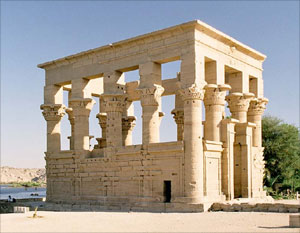The main temple on the island of Philae is the Temple of Isis, but there also a number of smaller temples and shrines dedicated to other deities and pharaohs and a Nilometer.

Minor temples and buildings
- 1: Nectanebo’s Kiosk
- 3: Temple of Ary-hes-nefer (Hor–Anhur)
- 4: Chapel of Mandulis
- 5: Chapel of Imhotep
- 12: Temple of Horus the Avenger
- 13: Temple of Augustus
- 14: Roman Gate
- 15: Roman Quay
- 16: Temple of Hathor
- 17: Trajan’s Kiosk
Temple of Isis
- 2: West and East Colonnades
- 6: Gate of Ptolemy II
- 7: Outer Courtyard
- 8: Mammisi (birth house)
- 9: Nilometer
- 10: Temple of Isis
- 11: Hadrian’s Gate
Nectanebo’s Kiosk
The kiosk or vestibule of Nectanebo is a pillared hall which originally had fourteen Hathor-headed columns, only six remain) linked by six-foot high walls topped by a row of concave cornices and uraeus-serpents. The walls are decorated with reliefs showing Nectanebo sacrificing to the gods.

Temple of Hathor

Down south from here on the eastern side of the island adjacent to the main temple complex of Isis is the temple of Hathor, constructed by Ptolemy VI Philometor and Ptolemy VIII Euergetes II. The temple included a colonnaded hall and a small forecourt. The hall was decorated by Augustus with depictions of the festivals in honour of Isis and Hathor. People eat, drink, and dance while Bes plays the harp and the tambourine (accompanied by a number of apes who also play instruments or dance). Augustus is also depicted presenting offerings to Isis and Nephthys.
Temple of Ary-hes-nefer
The temple was built by Ptolemy IV Philopator and extended by Ptolemy V Epiphanes. The decorations depict these two pharaohs with Isis, Horus, Unnefer (one of the names of Osiris) and other gods (including Horus the Elder, Nephthys, Khnum, Satet, Anuket, Ary-hes-nefer, and Tefnut). The roof is only partial and only six of the seventeen columns still have their capitals.
Chapels of Mandulis and Imhotep
To the north of the Temple of Ary-hes-nefer there are the remains of a ruined chapel dedicated to Mandulis (sun god of northern Nubia). At the northern end of the colonnade is the Temple of Imhotep (the deified vizier and architect of Djoser). Ptolemy V Epiphanes is depicted with Imhotep.
Temple of Horus the Avenger
To the north of Hadrian’s gate on the western side of the island there is a ruined temple dedicated to “Horus the protector (or avenger) of his Father” (Harendotes, a form of Horus the Elder) built by the Emperor Claudius.
Temple of Augustus
North of the Temple of Isis there is a ruined temple constructed by Augustus. Archaeologists found a stone bearing a trilingual inscription referring to Cornelius Gallus (the first Roman Prefect appointed after the death of Cleopatra VII) in this temple recording the suppression of an Egyptian revolt in 29 BC.
Roman Gate and Quay
North of the temple of Augustus is a Roman gate that leads to a landing quay along the northeast side of the island. The gate is thought to have been a triumphal arch built by the Roman Emperor Diocletian.
Trajan’s Kiosk

The Kiosk (sometimes referred to as “Pharaoh’s Bed”) is usually attributed to Roman Emperor Trajan, but it could easily have been built before his rule and simply adapted at a later date. It was a rectangular building in which fourteen columns with floral capitals supported a wooden roof. Two of the walls between the columns are relatively intact and are decorated with images of Trajan burning incense in honour of Isis and Osiris and presenting wine to Isis and Horus.
Coptic Churches
Two ancient Coptic churches and the remains of a Coptic monastery were discovered when the site was cleared and the temples relocated. There may have been a further two Coptic churches on the island, and there is documentary evidence that there was a Bishop of Philae in 362 AD. There were also the remains of the settlements in which the Coptic priests and church staff lived, but these were abandoned when the temple was relocated and have been completely destroyed by flood water.
Bibliography
- Arnold, Dieter(1999) Temples of the Last Pharaohs
- Bard, Kathryn (2008) An introduction to the Archaeology of Ancient Egypt
- Kemp, Barry J (1991) Ancient Egypt: Anatomy of a Civilisation
- Wilkinson, Richard H. (2000) The Complete Temples of Ancient Egypt
- “The Ptolemaic Period”, Allan B. Lloyd and “The Roman Period”, David Peacock in The Oxford History of Ancient Egypt (2000) Ed I. Shaw
Copyright J Hill 2009